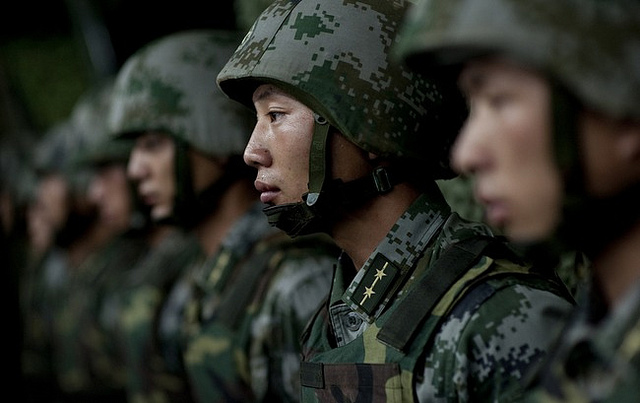
The balance of military power in Asia is of critical interest to Australia and other regional states. China’s modernisation of its defence forces has led to a reorganisation of its command structure, which was
announced late last year. Greater emphasis will now be given to air and defence forces rather than land based forces. This shift in emphasis will be helped by the sales of weaponry from other countries, particularly from the European Union.
In principle, the EU maintains an embargo on weapons sales to China but it’s getting a little frayed around the edges. The 16th EU–China summit meeting held in Beijing in late November last year made no change to the embargo. Nevertheless various media reports have given details about
the sale of technology that has been incorporated into Chinese weapons systems.
The embargo was
imposed after the Tiananmen Square massacre of 1989 (PDF). The EU took the view that it didn’t want any of its weapons to be used in suppressing dissent in China. That view remains an important reason for maintaining the embargo, but the possibility of EU arms being used for external aggression has been added to the criteria for maintaining it. Abandonment of the embargo might risk the interpretation that it was wrong to impose it in the first place after the Tiananmen Square violence.
Other pressures have contributed to its maintenance. The US has strongly opposed any lifting of the ban, mindful that it might feel compelled to defend Taiwan should mainland China attack it.
The State Department said in 2005: ‘We don't want to see a situation where American forces face European technologies’.
Japan also
strongly opposes a lifting of the embargo. The declaration by China of the East China Sea Air Defence Identification Zone (ADIZ) which includes the disputed Senkaku (Daioyu) islets will undoubtedly reinforce Japan’s opposition to any lifting. So will China’s assertiveness in other disputes.
Unsurprisingly, China strongly opposes the embargo. Various arms manufacturers in Europe have likewise opposed it, some suspecting that the US wants eventually to claim the China arms market for itself. The US has been more rigorous in its embargo against selling weapons to China.
Russia and Israel are major exporters of weaponry to China. Just how advanced the weaponry is that Israel exports is a matter of some contention because Israel has access to some of the latest US technology. Whether Israel would sell US-based high-level arms technology to China and run the risk of outrage and possibly reprisals from Washington is one of the intriguing questions in the US–Israel relationship. When Israel tried to
sell advanced airborne early warning radars to China in the face of American pressure to desist, they
eventually withdrew from the deal and incurred a penalty of some $350 million. An Israeli official who knew of some sales was
forced to resign.
The very fact that Israel sells weaponry to China is one of the points made most frequently by those who would like to see an end to the European embargo. From the point of view of European arms manufacturers, the embargo generally means that they can’t sell all they would like to a country that has plenty of money to spend and which is rapidly arming. European firms need licences to export defence equipment.
In a possible effort to maintain its pride and to downplay the importance of the embargo, China says that its dependence on foreign arms imports is overstated by Western commentators: it’s a major arms exporter in its own right. The Stockholm International Peace Research Institute (SIPRI) lists China as
the world’s fifth biggest exporter of arms in 2008–12, with anti-ship missiles, helicopters, radar systems and aircraft being among the major items sold.
The EU left the interpretation of what could be sold to the individual countries. Both
France and
Britain appended their own interpretations to
the EU declaration. Many of the sales to China have been of dual use technologies which don’t need the special export licences.
A
December 2013 Reuters report lists the following European arms equipment being used by China:
- French sonar, anti-submarine warfare helicopters on Chinese destroyers.
- French and German diesel engines on surface warships.
- British jet engines on PLA fighter bombers
- British airborne early warning radar on Chinese surveillance aircraft
- Eurocopter designs for attack and transport helicopters.
- German-engineered diesel engines from MTU Friedrichschafe on large numbers of the Chinese submarine fleet.
Some of these items include technology that had its origins in the US.
China is also developing its own global navigation system which will rival both GPS and the Europe-based Galileo system. Co-operation between the EU and China contributed to this, though China withdrew some time ago from further financial contributions to the European research. The system will contribute to space research and to the development of drones.
European countries aren’t selling complete defence systems to China but they are selling some pretty important components.
Stuart McMillan is an adjunct fellow in the school of social and political sciences at the University of Canterbury. He is also a research associate in the National Centre for Research on Europe in that university. Image courtesy of Flickr user Asitimes.[3] the sale of technology that has been incorporated into Chinese weapons systems: http://24allnews.com/chinese-militarys-secret-to-success-european-engineering/
 Print This Post
Print This Post